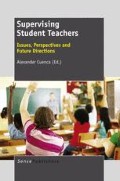Abstract
In 2005, Molly MacGregor, executive director and co-founder of the National Women’s History Project, was asked what she felt worked in terms of fostering gender equity in the classroom. MacGregor answered, “The teacher is key-his or her attitude and knowledge is pivotal” (Hahn, et al., 2007, p. 348).
Access this chapter
Tax calculation will be finalised at checkout
Purchases are for personal use only
References
AAUW. How schools shortchange girls. Washington, DC: AAUW; 1992.
AAUW. Gender gaps: Where schools still fail our children. Washington, D.C.: AAUW; 1998.
AAUW. Beyond the “gender wars”: A conversation about girls, boys, and education. Washington, D.C.: AAUW; 2001a.
AAUW. Hostile hallways: Bullying, teasing, and sexual harassment in school. Washington, D.C.: AAUW; 2001b.
Baumgardner J, Richards A. Manifesta: Young women, feminism, and the future. New York: Farrar, Straus and Giroux; 2000.
Bernard-Powers J. Engendering social studies: Perspectives, text, and teaching. Theory and Research in Social Education. 1996;24(1):2–7.
Brown, S. P. (2000). Teaching our teachers. Women’s Studies Quarterly, 3 & 4, 154–163.
Campbell PB, Sanders J. Uninformed, but interested: Findings of a national survey on gender equity in pre-service teacher education. Journal of Teacher Education. 1997;48(1):69–76.
Clark R, Ayton K, Frechette N, Keller PJ. Women of the world, re-write! Women in American world history high school textbooks form the 1960s, 1980s, and 1990s. Social Education. 2005;69(1).
Cochran-Smith M. Learning to teach against the grain. Harverd Educational Review. 1991;61(3):279–310.
Crocco M, Libresco A. Citizenship education for the 21st century- A gender inclusive approach to social studies. In: Sadker D, Silber ES, editors. Gender in the classroom. Mahwah: Lawrence Erlbaum Associates; 2007.
Cruz BC, Groendal-Cobb JL. Incorporating women’s voices into the middle and senior high school history curriculum. The Social Studies. 1998;89:271–275.
Dam, G. t., & Rijkschroeff, R. (1996). Teaching women’s history in secondary education: Constructing gender identity. Theory and Research in Social Education, 24(1), 71–89.
Faludi S. Backlash: The undeclared war against American women. New York: Crown Publishers; 1991.
Guyton E, McIntyre DJ. Student teaching and school experiences. In: Houston WR, Haberman M, Sikula JP, editors. Handbooks of Research on Teacher Education. New York: MacMillan; 1990.
Hahn CL. Gender and political learning. Theory and Research in Social Education. 1996;24(1):8–35.
Hahn CL, Bernard-Powers J, Crocco MS, Woyshner C. Gender equity and social studies. In: Klein S, editor. Handbook of Research on Gender Equity. Mahwah, NJ: Lawrence Erlbaum Associates; 2007.
Kumashiro KK. Against Repetition: Addressing resistance to anti-oppressive change in the practices of learning, teaching, supervising, and researching. Harvard Educational Review.. 2002;72(1):62–92.
Lerner G. The creation of the patriarchy. New York: Oxford University Press; 1986.
Levstik, L. S. (1997/1998, Winter). Early adolescents’ understanding of the historical significance of women’s rights. International Journal of Social Education, 12(2), 19–34.
Levstik LS. Daily acts of ordinary courage: Gender-equitable practice in the social studies classroom. In: O’Reilly P, Penn EM, DeMarrais K, editors. Educating young adolescent girls. Mahwah, NJ: Lawrence Erlbaum Associates; 2001. p. 189–211.
Lundeberg MA. You guys are overreacting: Teaching prospective teachers about subtle gender bias. Journal of Teacher Education. 1997;48(1):55–62.
Marcus AS, Monaghan MM. Tasting the fluoride: Using feature film to inspire modern-day critical consciousness. Social Studies Research into Practice. 2009;4(1).
McIntyre DJ, Byrd DM. Supervision in teacher education. In: Firth G, Pajak E, editors. Handbooks of research on school supervision. New York: Macmillan; 1998. p. 409–427.
Noddings, N. (1991/1992). The gender issue. Educational Leadership, 49(4), 65–70.
Noddings N. Social studies and feminism. Theory and Research in Social Education. 1992;20(3):230–241.
Robinson KH, Ferfolja T. “What are we doing this for?” Dealing with lesbian and gay issues in teacher education. British Journal of Sociology in Education. 2001;22(1):121–133.
Sadker M, Sadker D. Failing at fairness: How America’s schools cheat girls. New York: Charles Scribner’s Sons; 1994.
Sanders J. Something is missing from teacher education: Attention to two genders. Phi Delta Kappan. 2002;84(3):241–244.
Schuster, M. R., & Van Dyne, S. (1998). Placing women in the liberal arts: Stages of curriculum transformation. In C. A. Woyshner & H. S. Gelfond (Eds.), Minding women: Reshaping the educational realm (pp. 79–96). Cambridge, MA: Harvard Educational Review (reprint).
Tetreault MKT. Integrating women’s history: The case of United States history high school textbooks. The History Teacher. 1986a;19(2):211–262.
Tetreault MKT. It’s so opinioney. Journal of Education. 1986b;168(2):78–95.
Wineburg S. Historical thinking and other unnatural acts: Charting the future of teaching the past. Philadelphia: Temple University Press; 2001.
Author information
Authors and Affiliations
Rights and permissions
Copyright information
© 2012 Sense Publishers
About this chapter
Cite this chapter
Monaghan, M., Hartigan, B.F. (2012). Gender Equity in the Classroom. In: Supervising Student Teachers. SensePublishers, Rotterdam. https://doi.org/10.1007/978-94-6209-095-8_8
Download citation
DOI: https://doi.org/10.1007/978-94-6209-095-8_8
Publisher Name: SensePublishers, Rotterdam
Online ISBN: 978-94-6209-095-8
eBook Packages: Humanities, Social Sciences and LawEducation (R0)

